#quarterhorses
Explore tagged Tumblr posts
Text

R&DR Get 'Em Excited | Red Roan AQH Stallion
We had a great day showing this afternoon. Getty was the perfect gentleman in the arena. Looking forward to the next show with him. He is an absolute dream!
23 notes
·
View notes
Text



A Blue Roan Quarter Horse stallion. Gosh he's so handsome isn't he? I had a blast creating him.
Gallery ID: sadasha21
What do you think?
24 notes
·
View notes
Text

art gift for a friend
3 notes
·
View notes
Text
Gonna bitch about part 7 rq but diego deserved to win bc he had the most optimal horse for a 3000 mile race.
#ooc | and i won't be part of this in the end#MOTHERFUCKERS IN SBR HAVING QUARTERHORSES AND MUSTANGS AND SHIT!!!!!!!#THOSE ARE NOT THE BREEDS BUILT FOR STAMINA OR LONG TREKS OHHH MY GOD.#im not a horsegirl. however#i took an animal science class.#quarterhorses are for races of a quarter mile.#they are known for their speed in a short race and able to outclock other breeds of horse#thoroughbreds are what you NEED for a race like sbr#what do YOU MEAN POCOLOCO WON ON A QUARTER HORSE AAAAAUGH#edit: diego had an arabian thoroughbred no less!!!#arabians are known fr their long distance stamina#silver bullet kicks ass.
4 notes
·
View notes
Text
May I present: (Certain) Western Pleasure Quarterhorses
They may be bred to have poor conformity
They are trained to move so so slow that their gaits are unrecognizable
Due to conformity issues or wretched, labored gaits, they are often lame (in pain and gaits are visibly affected)
Eg:
From above reddit thread:


A non-reddit source for your pleasure:
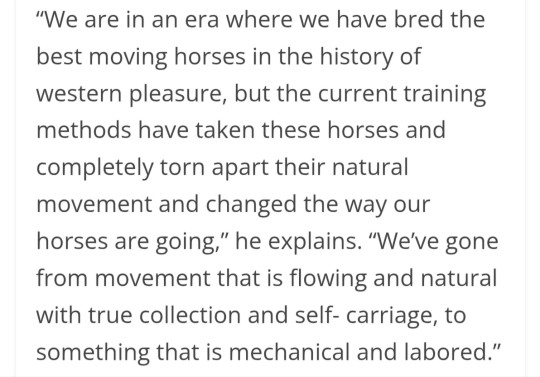
I wonder if I could start an argument among horse people by asking one question:
Which horse breed, in your opinion, is the cybertruck of horses?
#the shouldn't exist looks bad falls apart can't get wet of horses you say?#i mean...people don't typically breed horses to be useless...i guess the closest you could get would be the grossly overbred quarterhorses?#like “quarterhorse” = good solid horse. but western show stock quarterhorse....i am retelling others' tales here please bear in mind....#apparently some people in the western pleasure show circuit are very very obsessed with getting a gait that is...smoother? i guess? but#other (“normal”) western riders say those horses just like. don't move right.#hmm ok lemme gather some sources#....after very little googling...#*voila* (wrote the post)
1K notes
·
View notes
Text

I miss riding horsies so bad this was an arabian i rode a few weeks back on a trail … his name was sonnet and he loved to power walk (racing the other horses for no apparent reason) 🏃♂️
#mainly doing western ive only rode quarterhorses#arabians really do be like that#he was a very good boy tho i miss horsies every day#<— born to cowboy up forced to get a degree
1 note
·
View note
Text

A Quarter Horse on a trail ride, Topanga Canyon 2020
0 notes
Video
youtube
🚀 Hermeus Begins Testing for the Quarterhorse Mk 2 Hypersonic Aircraft! 🚀
#youtube#Hermeus Hypersonic Aviation Quarterhorse Engineering Innovation SR71 FutureTech Aircraft SpeedRecords FlightTesting TechNews Aerospace Super
0 notes
Text
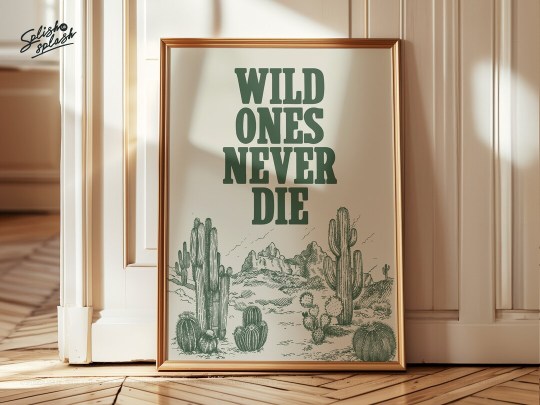
Wild Ones Never Die Instant Download, Vintage Horse Art Print, Western Art for Ranch Home, Cowboy Artwork by splishsplashlab http://dlvr.it/T6N6fQ
#western#cowboy#cowgirl#fashion#horse#rodeo#country#westernfashion#horses#westernstyle#westernwear#reddeadredemption#photography#cowgirlstyle#wildwest#rdr#rodeofashion#love#texas#style#horsesofinstagram#quarterhorse#westernlifestyle#handmade#ootd#cowboys#equestrian#onlineshopping#rodeostyle#countrygirl
0 notes
Text




My sweet heart breaks, so be careful But this pain ain't red, now it's a yellow
23 notes
·
View notes
Text
i know its to make them Fast but like. race horses can have real fucked up conformation sometimes.
#:V#tho its mostly quarterhorses.. someone needs to make them look like normal horses again#also doesnt help that many of them do just have like maybe 10 unique horses in their lineage#and thats not good!
0 notes
Text
[enters the dim interrogation room, pulls out a chair and plops a file upon the table before you]: So where are the other three-quarters of the horse?
1 note
·
View note
Text
love the idea of hikari in part 7. The multiverse girl is in the multiverse part, AND that bitch has a horse now.
#ooc | and i won't be part of this in the end#horse's name is rainbow gravity btw shes a 5 yr old thoroughbred.#palomino coat#hikari's a farmer she knows her horses and knows that whoever enters a quarterhorse in the sbr is an Idiot and a Fool#they're built for races of a quarter mile. yeah they're the fastest but thoroughbreds are built for speed for an extended amount of time#and have the stamina to bolster that.
4 notes
·
View notes
Text
Teen summer
Sitting quietly on an August morning, pondering my teen daughter's summer.
Her older brother moved out, down to Home Farm, and acquired a Roommate - so she not only got to spend lots of time in Brother's house, but also received a free, bonus brother. Roomate brought Missile the thoroughbred/quarterhorse cross to the pasture, so they have been riding a whole LOT more than she would have ridden on her own. The had to ride after dark through the worst of the heat, but horses have decent low light vision; no problem.
She had ordinary chores; farm animals, cleaning, a bit of cooking and canning, and garden - but only a very reasonable amount. She had one summer class online, but it was a rather compact seven weeks, and not too hard.
Friends. Tons of friends, really. College friends who traveled here to guest with us for a weekend, local friends. She is very blessed that way.
Swimming. Riding. Hiking. Catching crayfish. The Fair. Berrying. Caving. Travel. Family events. Gardening. Crochet, painting, drawing. We didn't manage to do the biking we wanted to do, but there's always something that falls off the list.
It's hard not to be jealous, really. But I know how hard I worked to break cycles and provide my kids with the opportunities they have for a safe, peaceful, pleasant life. Success comes as a surprise.
She's packing, now to leave for school on Sunday. I sure will miss her.
34 notes
·
View notes
Text
Tack And Upkeep: The Equine Influencer's Daily Routine
This is a continuation of my post, "Horses: Since There Seems To Be A Knowledge Gap". The first post I'm pretty satisfied addressed general horsie behavior and what's genuinely realistic in portraying horses, riding, and the relationships between horses and their riders that most people just plain don't know because you only learn it by working with them. The overall reception to the first post has been sincerely touching and inspiring from those of you who have shared and tagged or commented, so let's expand your knowledge some more! In this post, I'll be addressing the specific routines horses go through on a daily basis to be happy and healthy, and covering the different names and uses of tack.
Warning: This Is Going To Be A Very Long Post And So I've Placed A Readmore Below
Phase One: The Asscrack of Dawn
Horses are extremely high-maintenance and demanding animals when it comes to their routine upkeep. They're highly routine-focused, and will literally scream at the tops of their lungs if you're late in getting to the barn. If you think your cat is strict with their daily routines? It's because they learned it from horses, I'm 99% sure. My mom was once late as a teenager to getting to her horse and feeding him breakfast. He responded by picking the latch on his stall door, escaping from his paddock, and nosing his way past her bedroom window to whinny at her asleep in bed so she would get up and feed him. Like "I know where your stall is, too!"
Horses usually want to start the day in the pre-dawn hours. This is why stable hands and squires are essential throughout history. We adorn our eye crusties from rolling out of bed around 4am with oat dust as we head to the barn and first start with breakfast while you're able to stay in bed and sleep in time to get to work without being so sleep-deprived you walk into your car door instead of getting inside it.
So, what do horses like to eat anyway?
-Hay: The generic Wheaties of the horse world. Hay is a mix of dried grasses and healthy herbs meant for general munching and snacking on when the horse is in their stall or otherwise has no access to a pasture for grazing. They tend to be pretty "meh, okay" on being presented with hay, which we stable hands deliver in wheelbarrows and go from stall to stall filling each horse's individual feed bucket/trough. Hay and straw are not the same. Straw isn't very edible for livestock, and is almost exclusively used for insulation and bedding instead of food.
-Alfalfa, aka Clover flakes:
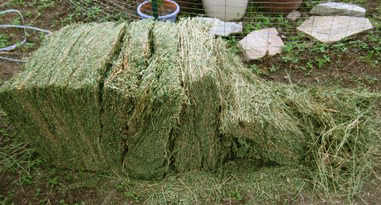
(source)
Alfalfa flakes, or clover flakes as I'm used to saying, are a sweet-smelling, green bale of lightly dried and compressed alfalfa and clover. The bale itself can be broken up into flat, square "flakes" that we often present to horses like treats. The flakes can either be placed on the ground in the stall (not recommended; they poo and pee there), or in a loose net, open-topped grid, or some other form of mounted feeder they can comfortably snack on. The flakes themselves smell very sweet, herbal smell that was always my favorite when I was a stable hand.
-Oats: Oats are kind of the treat of treats for horses, and are carefully measured and controlled when it comes to portioning. Horses tend to love oats so much that, if allowed to, they will literally eat until their stomachs rupture and die. Every barn and every horse has different dietary needs, such as ratios for oats vs. alfalfa vs. hay in order to keep them healthy.
-Molasses: Horses absolutely love sugar, but molasses in particular is something they go crazy for. When I was learning to barrel race and was establishing my working relationship with my Quarterhorse, Chip, my mom would help me out by making homemade horse treats consisting of rolled oats, molasses, and chopped up bits of apple that I'd slip to him when it was time for me to bring him his breakfast.
-Apples: The stereotype is true that horses adore apples, carrots, and other safe-to-eat fruits and veggies. But again, we treat these like actual treats, since they wouldn't be something a horse could safely eat in large quantities without developing stomach and intestinal problems.
-Thistles:
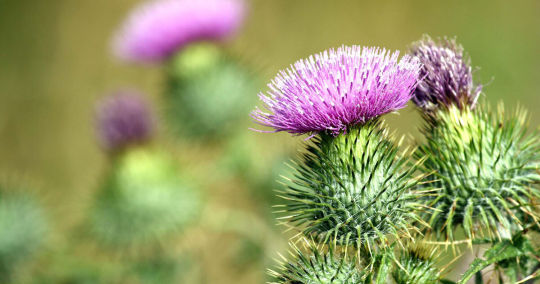
(source)
Horses go absolutely hogwild for thistles like the ones that grow in Scotland, Ireland, England, and Wales. They're a common sight along a lot of roads in the US nowadays, too, and while they're spiky as hell to us, horses are kinda like giraffes in that they have very tough mouth and tongue tissues designed to be tough against thorny and rigid vegetation. If you happen to be a fan of artichokes (also thistles), you may understand why horses get so excited to eat the little purple flowering ones! They're just yummy to 'em.
A very good rule of thumb to follow when it comes to writing up a rough feeding routine for your OC's horse, think of the natural ratios of food a wild horse would find. They would mostly eat grasses, with limited access to grains and fruits, and alfalfa/clover only tends to grow in large patches compared to the way grass likes to spread everywhere, so even the alfalfa would be lower on the list of most-eaten foods for a horse. As for stuff like thistles; those are treats even among horses. Stable hands will put up with a lot of literal horseshit, but the horses can forage for thistles themselves.
Phase Two: Bathtime
Now, routines can vary, but in my experience, the horses tend to be more relaxed and cooperative for cleanup time after they've been given breakfast, but every owner runs their barn differently.
The first thing we do is put a halter on. This is a halter:
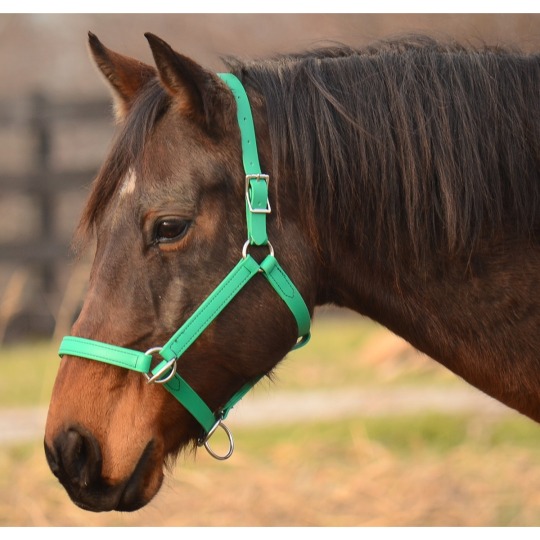
(source)
The difference between a halter and a bridle is a bit like the difference between a sports bra and a steel-boned corset: One you can stand to sleep in if you have to, while the other is there for good looks and tight control. Most horses don't mind wearing a halter 24/7, while others are crafty enough to figure out how to rub their heads against a tree/fence/stable door to slip their halter off.
It is possible to ride with a halter instead of a bridle, but you basically have to be willing to trust the horse with your life/are learning to ride bareback (although even bareback riders will often still use a halter or bridle for their own safety, and to control the horse when they're not riding it). 99% of the time, the halter is just there to help us stable hands guide and direct the horse to where we need them to be, with the rings on the halter used for clipping things like ropes to them to control the horse's head:
(source)
The above image is a good idea of how we "control" the horse's head. In the barns I worked at, we usually took the horses to a hitching spot just outside of the tack room to keep them warm inside while we prepped them for the day.
Once the horse is comfortable and properly controlled in place, it's first time to "swamp out" the stall behind them! A horse's stall only stays clean when the horse isn't in it, and so every time you're preparing to take the horse out or put them in their stall, it's essential to clean the stall first. This means shoveling poo and soiled straw and hosing down the stall floor (most modern barns these days keep heavy rubber mats on the stall floors to keep the horses warmer and more comfortable in general), distributing fresh straw for them to sleep in, refilling water buckets, and topping off hay feeders. Once all that's done, we turn our attention to the horse.
Bathtime Stage 1: The Gear
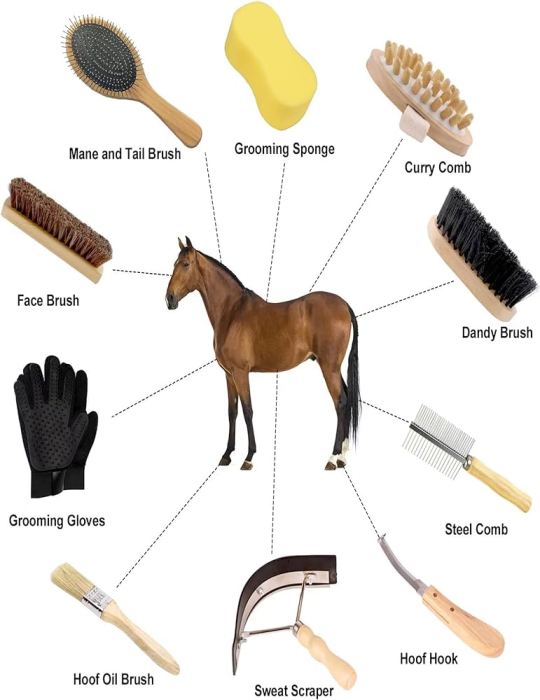
(source)
The diagram above is a bit fussy and more meant for show horses, but it gives the gist of what all we use to make sure the horses have their best glam day, every day. We'll often keep our grooming tools in designated bags or buckets that just make keeping track of our tools a lot easier than getting them one at a time.
ADVISORY: NEVER WALK BEHIND A HORSE, NO MATTER HOW MUCH YOU TRUST AND LOVE THEM! The biggest etiquette no-no you can commit when practicing horse safety and working with horses is to walk behind them. Horses have nearly 360 degree vision, with their only blind spots being directly in front of and directly behind them. When you're in a horse's blind spot, if it's spooked in any way with its head restrained, its first response will be to kick. A kick from a horse can absolutely be lethal depending on how big the horse is, where they hit you, and how hard they kick. A horse will easily kill you by breaking your skull if their back hoof impacts your head. To avoid being kicked by a horse if you have no other way to get around them, you literally hug their butt with your body while scooching around to the side you need to get to. Only once you're clear of the horse's back hooves can you un-hug that booty and step away. That way, if the horse does decide to kick, they're more likely to scoop you up on their legs and knock you aside than pummel you with an iron-soled fist made of thumbnails compressed to be hard enough to crush a wolf's skull.
Bathtime Stage 2: Brushies!
Now, brush time is usually happy time for the horse! It feels good and is very much like stimming for them. On more than one occasion, I've actually had horses doze off and start snoring while standing up as I was brushing them because they were having such a nice time. It's a myth that horses always sleep standing up like cows do; they usually hunker down in their piles of straw and curl up like even bonier borzois, but they can nap standing up. And yes, horses can and do snore! They can fart hilariously loud, too. I've never heard such thunderous cheek-clapping as when I've heard horses farting.
Generally speaking, the body-brush we use is called the "dandy brush" in the above diagram, but I was always used to calling it the "bristle" brush, because they're usually made with the bristles taken from wild boar hides to make them. We generally brush their bodies with the dandy brush for as long as our arms can hold out, because you never can get all the dirt and shed hair out when you're brushing a horse, and we're going to bathe them anyway.
Some horses don't like having their faces brushed, and don't usually need it unless they actually have gotten dirty. That's when we use the face brush, which is much narrower with denser, yet slightly softer bristles for working out mud spots and dirt without irritating the horse's skin. I, personally, would only spot-clean visible dirt, and then use a small washcloth during bathtime to give horses a face wash.
A "curry comb" is just a brush with very thick, firm pegs or wire bristles that's meant for breaking apart thick cakes of mud matting in the horse's hair. Horses instinctively like to roll in mud and dirt as a natural way of keeping pets like flies away and to keep cool in the heat - especially after they've just been bathed and prepped for a show goddammit - and so they can come in from the pasture pretty heavily caked in mud, and proud of it. Curry or wire combs just help break up dried mud and loosen it from the horse's skin so it's easier to wash out.
Combing a horse's mane and tail are also essential to their care, just like it's important to care for your hair on a regular basis to keep it from matting and getting yucky. Their manes and tails tend to be very, very wiry and stiff, and it can be surprisingly tricky to work out tangles and knots. Along with a very sturdy steel comb, sometimes we'll use something like coconut oil - which is safe for their skin and if they ingest it - like a natural leave-in conditioner to help us work out bad tangles without hurting the horse. Braiding a horse's mane and tail is highly traditional, especially in folklore from the British Isles. To this day, legend says that if you find your horse's mane and tail braided overnight one day, the faeries snuck into the barn and did it as a show of favor!
There's actually a huge link between horses and Celtic folklore that's really fun to explore, but that's another post.
Stage 3: Hoof Picking
While stable hands and riders aren't necessarily trained to trim a horse's hooves, we do keep their feet and legs healthy through regular "picking". Maintaining a horse's hooves is how you can directly protect them from injury and illness, and is probably the most important part of a stable hand's job in prepping a horse for the day.
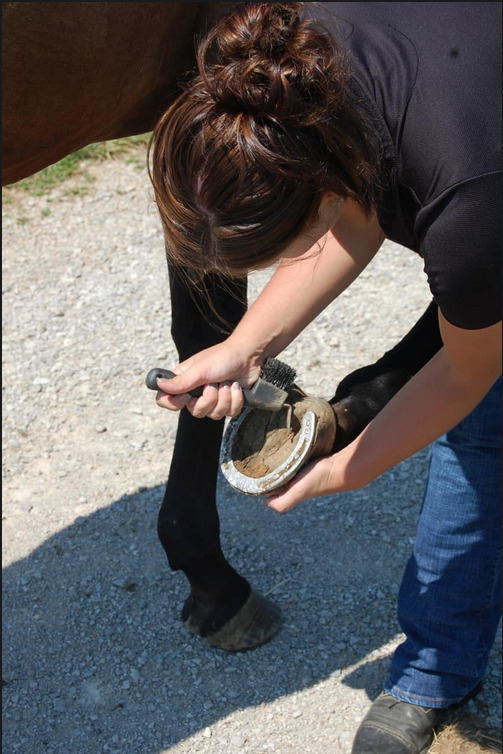
(source)
Horseshoes are always crafted to sit on the very outermost edges of the bottom of a horse's hoof, as that's where their feet spend the most time impacting the ground as they walk. As you look inward, their hooves actually have hollow spaces in the bottom like the arches to the sole of a person's foot. The person in the above photo is using a hoof pick to gently scrape out dirt, mud, rocks, and any other bad stuff that can get gunked up in those hollow spots.
In my experience, horses are often trained to lift each leg on command for picking-time by either a verbal command, or a gentle squeeze to the tendon on the leg you want them to lift. For most of my working time, the signal was two light squeezes on the back of the leg.
Once a horse lifts their leg up for picking, it's easier for people who have limited physical strength to straddle either side of the horse's bent leg, facing away from the horse's face, and help keep the hoof held up with one hand while picking and cleaning it out with the other. While we're picking, we're looking closely for anything that could hurt the horse later. The #1 worst thing to find in a horse's hoof is a rusty nail, which are very, very common around a farm setting, and can cause a serious and life-threatening infection if it's able to pierce the horse's foot. We also check for any smells or visual signs that the horse is injured or hurting.
Regarding horseshoes and nail trims: It's pretty uncommon for your everyday stablehand to trim your horse's hooves. A significant, yet essential, cost for any horse owner is maintaining a ferrier, or horse foot specialist, whose main job is to maintain a horse's feet. Many nowadays are also equipped to make and fit their own horseshoes on-site for if your horse "casts a shoe" (has a horseshoe come loose and fall off), so they can fit them with a new one at the same time as they're trimming up their nails. I met one ferrier that actually had a miniature forge in the back of his work truck. It was awesome watching him work.
Stage 3: The Bath Begins
For the sake of their long-term health, most working ranches will see to it that their horses are bathed daily - sometimes multiple times - just like giant dogs. Horses that aren't ridden every day or are otherwise kept more like pets don't typically need as much bathing, but you should never put tack on a dirty horse. Horses don't have fur; they have hair like humans do, and so we use special horse-formulated shampoos and conditioners for bathtime, even in winter when it's so cold your hands go numb carrying in the water buckets.
I've never encountered a horse that was bothered by cold water, but that's because I live in a region that gets very cold winters, and I always bathed horses inside the barn where it was warm on days where it was very cold out. Some horses will refuse to cooperate unless they have tepid or warm water to bathe with (or will only allow a cold water bath if it's already very hot outside), and you have to be careful when around their legs and feet, since they'll sometimes stomp their legs from the sensation of water dripping off them.
For the most part, you only need to wash a horse from neck to backside, and down their legs, and you want to get them wet with their bathwater first before you apply any shampoo. Then, gently rub/massage with a soft sponge or grooming gloves until caked-on mud gives way and the shampoo starts to really lift away dirt and grime. We always wash manes and tails, but we never use shampoo or soap on their faces! Like I said before, a soft, damp cloth and regular water is usually all that's needed to bathe a horse's face.
Blow-drying horses isn't usually something I'm used to seeing, as they don't tend to appreciate the noise. Microfiber towels, or even just regular paper towels, combined with a sweat scraper are usually enough to get the horse comfortable and able to air-dry the rest of the way. After the excess water is gone is when coat conditioners or skin moisturizers are applied, and if a horse needs to stay pretty before a show or event, it's not unusual to line their stalls with wood shavings instead of straw beforehand. Wood shavings wick away the moisture they want to roll off, and are also pretty easy to brush off before it's showtime.
Phase Three: Tacking Up
I'm going to break this up into two examples: English, and Western style tack. There is an absolutely massive array of different kinds of tack all over the world, but the most common forms of riding and tacking in the Western world are English and Western, and I'll be comparing the tack used in both.
Blankets:
English Saddle Blanket:
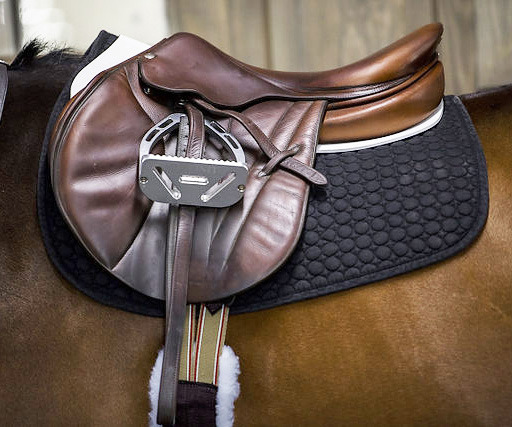
(source)
Western Saddle Blanket:
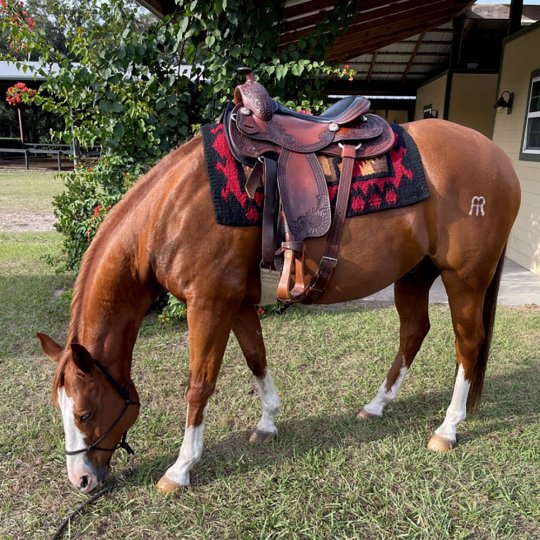
(source)
Blankets or saddle pads are essential to riding! Saddle blankets/pads help protect the saddle - which are universally Not Cheap - from the horse's sweat, dirt, and shed hair, the blanket itself also protects the horse from developing sores on their backs from the friction of the rider moving in the saddle. Generally speaking, the very first thing we grab when it's time to tack up the horse is the blanket or pad that goes under the saddle.
The essential aesthetic difference between Western and English blankets is mainly that: aesthetics. Western blankets tend to be a lot bigger and almost always rectangular, made of a heavy material like wool or alpaca fleece, and bearing some kind of flashy pattern woven into the blanket itself - the most common styles being either made by or reminiscent of local Native American art styles. An English blanket or pad is either much smaller (again, a key to the aesthetic of the English riding style is subtlety), can be made of smoother and lighter fabrics, and can even even cut specifically to fit beneath the saddle with as little excess material showing as possible.
Speaking of, a lot of indigenous groups in America sell things like hand-woven saddle blankets at shows, farmer's markets, and online as a way of supporting their community! There's nothing wrong with you, as a non-Native American, buying from a community that's willingly selling to you, and it's a great way to help both show them monetary support as well as show off their work to other potential customers. Horse-people talk a lot about where they get their gear!
Western vs English Saddles:
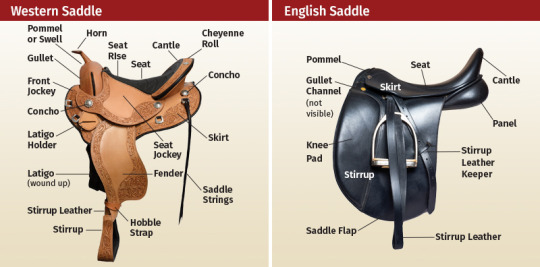
(source)
As you may be able to see, Western saddles are a lot more complicated than English saddles, mostly because they're designed for different types of riding.
English saddles, and English riding, is usually considered the typical "fancy rich people horse show" riding style, and the most common things done with that riding style is something commonly called "showing". Western riders tend to practice more competition-based, sports-centered riding, while English riding is more about showing off you and your horse's grace, etiquette, and bearing, and it's usually the horse that gets the most scrutiny out of the judges; being assessed for the quality of their gait and their precision and speed in completing tasks like a jumping obstacle course.
As a result, English saddles don't have that many bells and whistles to them, and generally tend to be designed to be as light and unassuming as possible. As I've said before, I've never liked English riding, because I feel fragile in the saddle and like I can't really get stable to go fast, as I am a speed freak in the saddle.
Western saddles were designed to be tough, heavy, stand up to a lot of abuse, and give the rider plenty of room on the horse's back to move around and work. Western saddles are built to be less likely to slide off the center of the horse's back if the rider has to lean hard on one stirrup (such as to shoot a gun sideways or lasso a sprinting cow before it can barrel off the side of a gully and get itself killed). The iconic horn is largely used for holding things like coils of rope, and it's considered a Western riding etiquette no-no to cling to the horn for stability. The horn is not there to stabilize you. It's there to keep your hands free.
The stirrups are also very different. A Western style stirrup needs to be much thicker underneath the rider's foot in order to give the rider a better platform to stand on, as well as more static friction (yeah, physics is involved in this stuff) to keep them stable in the saddle when the horse is moving very fast or very aggressively while they're also doing their own thing on the horse's back. The extra long fenders compared to the English knee pad are also there to help keep the saddle itself, which can weigh up to 60lbs/27kgs, centered so it doesn't slide and dump the rider off!
English stirrups are more there to slot into the heel of a riding boot, which always have a tiny bit of a heel regardless of whether it's designed for a male foot or a female one, as the heel serves an active purpose for the riding process rather than being there for fashion. Riding boots are designed with a channel in the heel to more securely and comfortably align with the stirrups, and don't need to be very thick or tremendously sturdy to heavy use, as English riding is more about showing off the skill and communication between the rider and the horse with as few flaws as possible vs. something more sports-oriented like target shooting, where the judges are factoring in your accuracy:speed ratio.
The Dreaded Cinch:
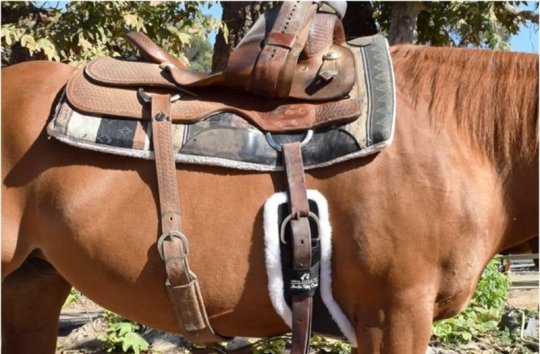
(source)
Depending on the rider and the style, a saddle can have either one or two cinches (leather belly straps). The frontmost strap usually fits behind the horse's front legs, out of the way where it could cause the horse any harm while running, and often comes with a pad to keep the strap from chafing the skin, and to help keep the front portion of the saddle centered. Most horses don't mind that strap, as it just needs to be tight enough to fit.
What every horse I've ever met hated is the center belly cinch, which is the primary cinch for a lot of riders. It's critical to keeping you, the rider, alive on horseback, but it's one of the least fun sensory experiences for the horse due to how tightly it needs to be drawn to keep the saddle steady regardless of speed. Some horses will inflate their bellies to look fatter while you're tightening the cinch up to try and trick you into leaving it a notch or two too loose. It doesn't actually hurt them to have the cinch properly tightened; they just find the sensation annoying and can get mischievous if they're having a lazy day.
After the belly cinch is tightened, if you share your saddle (such as if you're taking classes and rent the tack that goes on your horse), you also want to adjust the length of the stirrups to properly suit the length of your legs. If you own your saddle and aren't getting any taller or shorter, this is usually a skippable part because you've already done it a while ago.
Bridles:
Once again, there are different kinds of bridles for different uses! There are bitless bridles, like this:
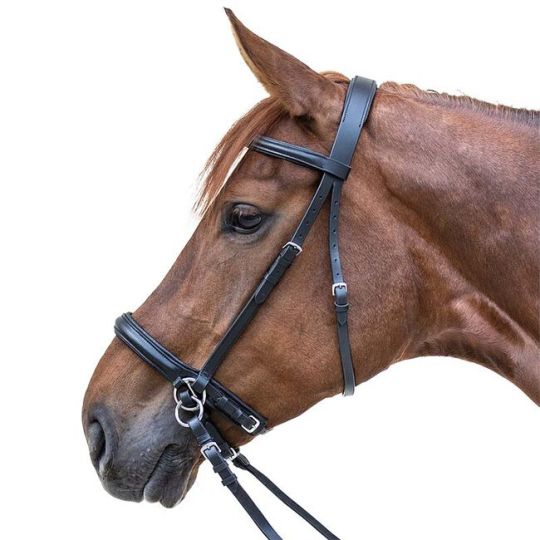
Reasons for using bitless bridles can vary. A bridle with a bit usually doesn't do any harm to the horse while providing more control to the rider over where the horse is going with its head. Horses that spook easily, are prone to misbehaving, or just aren't very thoroughly trained yet are usually trained on bridles with bits in order so the rider can take control of the horse's head and better guide them in the direction they need to go.
Bitless bridles are naturally more comfortable for the horse, since nothing has to go in their mouths, and allows for them to do things like graze freely if you're riding them out in pastures and spaces where you're likely to take breaks from riding in places where food is growing. Horses with sensory issues, that were late in being trained to ride, or that have dental problems a bit would irritate tend to do better with bitless bridles, but the rider themselves have to be willing to sacrifice that extra control and trust the horse more.
What are bits for and what types are there?
The main bit types I've seen most in my experience are Snaffle Bits.
Snaffle Bits:
(source)
As you can see, there are quite a few varieties of snaffle bits. In horse terminology, snaffle bits are considered "severe" bits, although they don't actually do any harm to the horse. "Severe" is more meant to describe the level of control and rigidity the bit provides to the rider compared to the level of freedom the horse has when they're riding together. Most horses are trained on and completely fine with snaffle bits, and if they do have any issues, the owner can switch types to see if the horse is more comfortable with a different type.
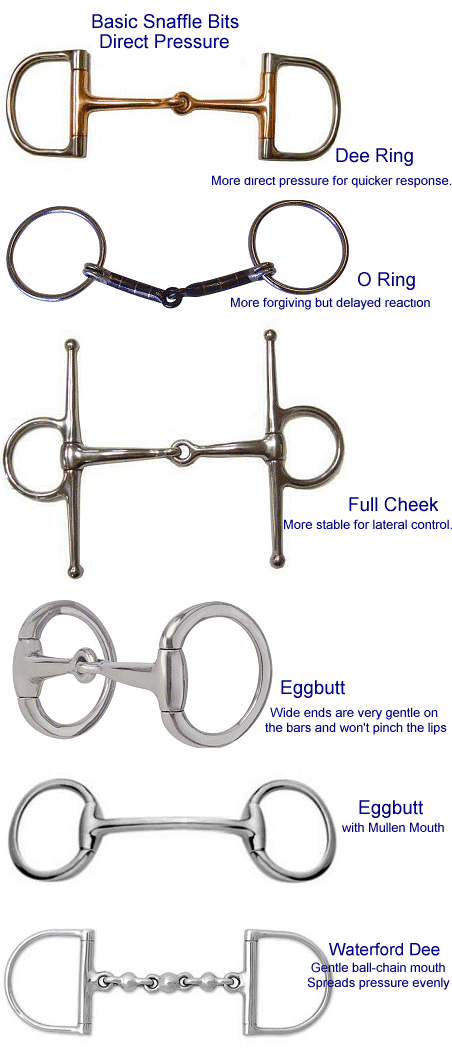
(source)
With bits, their primary uses are to communicate with and direct the course of the horse's head when the rider pulls on or relaxes the reins in their grip. Some horses can be very flighty and need the help of a sturdy bit that has the potential of pinching the corners of their lips if the rider has to pull too hard to get them under control in the event of a scare. For other horses that don't need as much correction or situational control, they respond best to the sensation of the metal's pressure even on their tongue and lower jaw and move in the direction they feel the metal press the most firmly in their mouth.
Bits do not automatically destroy a horse's teeth. What a lot of people who haven't worked with horses aren't totally conscious of is that horse's jaw looks like:
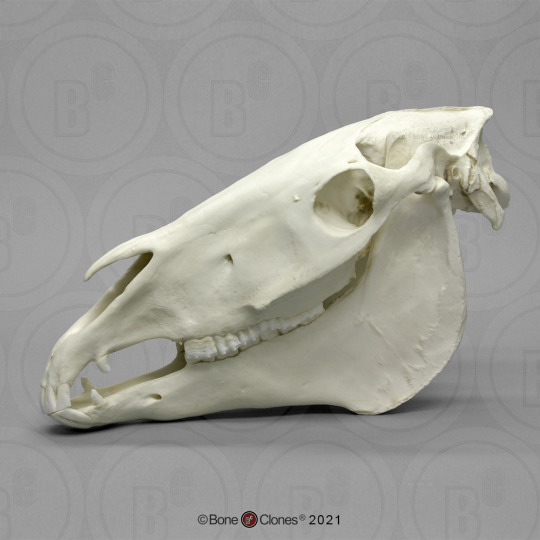
(source)
Between their frontmost teeth and molars, there's a huge gap where there's nothing but free space, and a bridle's bit is usually so small compared to the space the horse naturally has in its mouth that they can often comfortably graze and drink water with the bit still in, although some will try their hardest to spit the bit out when they want to eat, but that's more of a preference than a pain issue. Their front teeth are used for plucking food out of the ground (or biting the shit out of your unsuspecting stable hand's love handle when they're distracted), and they use their tongues to guide the food back toward their molars to chew. Experienced horses can often figure out how to eat around the bit still in their mouths, but they don't like it, and nice riders will take the bit out (you can do this without removing the bridle) when they're not needed so the horse can have its mouth back.
My character is in from riding. What's the routine like after you're done?
Firstly, if the horse is very hot and still huffing and puffing from all the work/running it's been doing, we'll swap their bridles out for halters, put them on a leading rope:
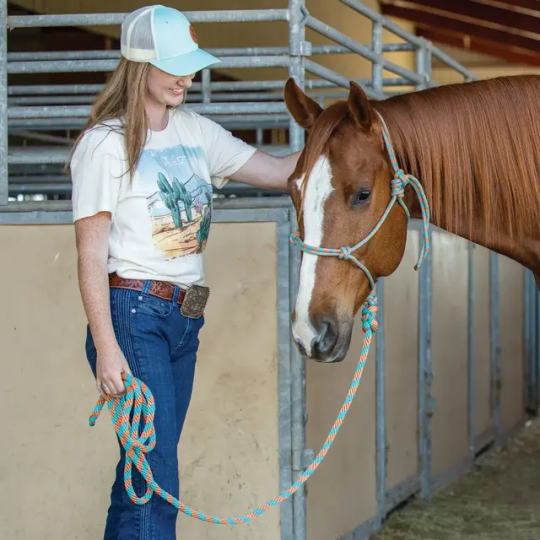
(source)
Which, yes, can be tied into a bridle if you aren't a raging lazy ass like I was if you have the right type of rope, and then we'll take the horse on a cool-down walk in the paddock or a covered arena.
Like joggers and other heavy-exercisers, it's essential for the health of the horse's heart to help them slowly wind back down from working themselves into a literal sweat for so their heart rate gently returns to a lower pace. Stopping an overheated and overworked horse cold can actually be more stressful on them than if you take them for a slow, steady walk (sometimes just in circles until they slow down to a stop on their own), until they're steady and relaxed enough to be ready to tack down, brush out, and either let them back out to the paddock to roam, or put them to bed in their stall for the night with some fresh food and water. Their hooves are re-picked and checked again for any signs of damage or wear, and if they're especially sweaty, may need some towel-off time with a sweat-scraper and actual towels or fistfuls of straw.
The final, most important part of the day:
Spending quality one-on-one time with the horse with no tack, no riding, and no fussing around with work. Horses love to play, they crave affection and attention, and are extremely intelligent and curious. They get zoomies. They can be complete dorks. They can be love-bugs. They can even be protectors. They love following their favorite people around and watching what they're doing, and even try to involve themselves somehow (usually by flagrant acts of hat/jacket theft). They can get bored and destructive like puppies and kittens. If they're lonely for you and you haven't visited in a while, they'll chew on the edge of their fence to comfort themselves - it's called "cribbing".
You know those videos showing quirky families that live with a horse in their house part-time or full-time? That's not that unrealistic for horses at all. They're highly social, and prefer to sleep and live in close groups. They love to be pet and scratched, and often will try to reciprocate shows of cuddling and affection the best they can.
When a horse loves their rider, riding becomes fun for them both! When there's a real bond between them, the tacking and riding process can all be part of what the horse perceives as play and bonding time. Horses that are trained to do handle other sports, such as horseback sharpshooting, barrel racing, racing in general, polo, and the like can also genuinely enjoy the sports they play like human athletes!
22 notes
·
View notes